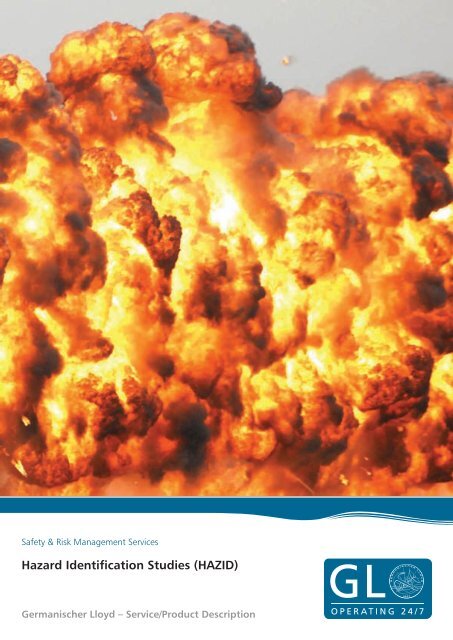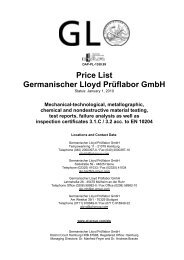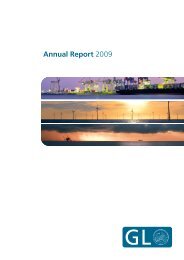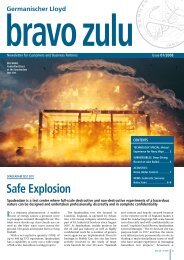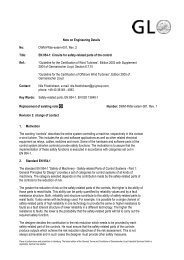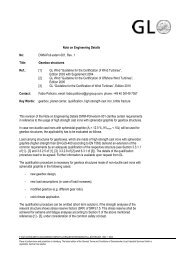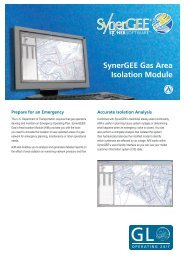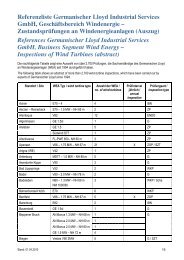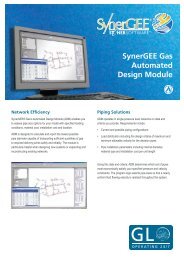Hazard Identification Studies (HAZID) - Gl-group.org
Hazard Identification Studies (HAZID) - Gl-group.org
Hazard Identification Studies (HAZID) - Gl-group.org
You also want an ePaper? Increase the reach of your titles
YUMPU automatically turns print PDFs into web optimized ePapers that Google loves.
Safety & Risk Management Services<br />
<strong>Hazard</strong> <strong>Identification</strong> <strong>Studies</strong> (<strong>HAZID</strong>)<br />
Germanischer Lloyd – Service/Product Description
<strong>Hazard</strong> <strong>Identification</strong> <strong>Studies</strong><br />
(<strong>HAZID</strong>)<br />
2<br />
Germanischer Lloyd – Service/Product Description<br />
Service Title: Safety & Risk Management Services<br />
Lead Practice: GL Plants & Pipelines (Germany)<br />
Page 3<br />
Pages 4 - 13<br />
a:<br />
b:<br />
c:<br />
d:<br />
e:<br />
Pages 14 - 15<br />
a:<br />
b:<br />
Contents<br />
Service Description and Values Generated<br />
Detailed Method Statement<br />
The detailed method statements explain how the<br />
work is conducted, which inputs are required and<br />
which outputs and results can be expected.<br />
<strong>Hazard</strong> <strong>Identification</strong><br />
Team Composition<br />
Execution of the <strong>HAZID</strong> Sessions<br />
Hazid Worksheet<br />
<strong>Hazard</strong> Checklists<br />
Case <strong>Studies</strong> and Examples<br />
Natural Gas Cavern Storage<br />
Maritime Oil Jetty in the River Danube
Service Description<br />
and Values Generated:<br />
Motivation<br />
The operator of a technical installation by which health and safety,<br />
the environment, assets and the operator’s reputation could be<br />
affected is obliged by European legislation to:<br />
have an up-to-date knowledge about all safety-relevant<br />
aspects of their operations,<br />
prevent accidents or to limit their impacts/escalations (as<br />
per the Seveso II Directive),<br />
control hazards reliably and to minimise risks by<br />
identifying installations with risk potential regarding<br />
health and safety as well as the environment, evaluating<br />
their inherent risks and specifying risk mitigation<br />
measures (which is part of the risk management process),<br />
design, start up, operate and maintain workplaces in such<br />
a manner that the workforce can conduct work without<br />
putting their own safety and health or that of others at<br />
risk.<br />
Objectives<br />
The objectives of the <strong>HAZID</strong> procedure offered by Germanischer Lloyd<br />
(GL) are to identify main hazards, to review the effectiveness of<br />
selected safety measures and, where required, to expand the safety<br />
measures in order to achieve a tolerable residual risk. In compliance<br />
with the Seveso II Directive, besides facility safety concepts for new<br />
installations, also safety concepts for existing operational facilities<br />
have to be reviewed.<br />
The analysis serves the operator as proof that installations are<br />
operated such that hazards for employees, third parties, the<br />
environment and the surroundings can largely be excluded. The<br />
operator’s management gets an up-to-date picture of the present<br />
hazards and their possible effects.<br />
By means of the <strong>HAZID</strong> analysis the primary process, but also<br />
non-process, hazards as well as their possible escalations can be<br />
identified due to the structured manner of the procedure. Employees<br />
can be advised of the relevant hazards concerning their working area.<br />
At the same time the outcomes can be taken as a support in<br />
compiling the required neighbourhood information. The facility<br />
designer considers the analysis results to improve safety concepts for<br />
new-built installations.<br />
SERVICE DESCRIPTION<br />
Frequency of Reviews<br />
<strong>HAZID</strong> analyses are usually to be revised when considerable<br />
modifications, upgrades or re-design of existing facilities are carried<br />
out or if events like accidents, critical situations or near misses call for<br />
this. In this context a change, upgrade or re-design is to be<br />
considered as essential if process modifications associated with<br />
consequences for safety or safety related equipment are involved. This<br />
also applies for utilities including buildings, machinery, equipment<br />
etc. that do not necessarily contribute to the primary operating<br />
objective but which are associated with the process facilities in terms<br />
of layout or operation and that are safety relevant. Those being in<br />
charge of operations and those working in the facilities are obliged<br />
to indicate all identified possible changes. In principle operators are<br />
expected to repeat the analyses at least every 5 years in order to<br />
maintain the residual risk as low as reasonable practical.<br />
Offered Service<br />
The service offered in this matter is the provision of an experienced<br />
facilitator/chairman and a minute taker who guides through the<br />
<strong>HAZID</strong> sessions in a formal and consistent manner and captures the<br />
relevant results into the prepared <strong>HAZID</strong> spreadsheet. Subsequently<br />
upon completion of the sessions a report is prepared by the <strong>HAZID</strong><br />
chairman and submitted to the client.<br />
3
4<br />
DETAILED METHOD STATEMENT<br />
a. <strong>Hazard</strong> <strong>Identification</strong><br />
<strong>Hazard</strong> identification (<strong>HAZID</strong>) is “the process of identifying hazards,<br />
which forms the essential first step of a risk assessment. There are two<br />
possible purposes in identifying hazards:<br />
To obtain a list of hazards for subsequent evaluation using<br />
other risk assessment techniques. This is sometimes<br />
known as “failure case selection”.<br />
To perform a qualitative evaluation of the significance of<br />
the hazards and the measures for reducing the risks from<br />
them. This is sometimes known as “hazard assessment”.<br />
During the hazard identification stage, the criteria used for the<br />
screening of the hazards will be established and possible hazards and<br />
accidents will be reviewed. For this purpose, the facility will be divided<br />
into several sections. Furthermore, the identified hazards will be<br />
classified into critical and non-critical hazards. It is of great importance<br />
that the hazards considered non-critical are clearly documented in<br />
order to demonstrate that the events in question could be safely<br />
disregarded.<br />
This failure case selection will be executed by generating check lists,<br />
accident and failure statistics, hazard and operability <strong>Studies</strong> (HAZOPs)<br />
or by comparison with detailed studies and experience from previous<br />
projects.<br />
The <strong>HAZID</strong> also includes the division of the plant into sections as<br />
mentioned above. An example of the section division is shown below:<br />
Table 1: <strong>HAZID</strong> section division. Example.<br />
For each of the areas which contain toxic or flammable inventories,<br />
the details are compiled, also including potential sources of ignition.<br />
The following sources provide further information on <strong>HAZID</strong><br />
techniques:<br />
CCPS (1992): <strong>HAZID</strong> techniques in the process<br />
industries<br />
CMPT (1999): <strong>HAZID</strong> techniques for offshore<br />
installations<br />
Ambion (1997): <strong>HAZID</strong> techniques for offshore<br />
safety cases<br />
The aim of the hazard scenario identification is the <strong>group</strong>ing of similar<br />
outcomes of different hazards.<br />
Based on the facts compiled in the <strong>HAZID</strong> stage, the major hazard<br />
scenarios can be identified. Usually the hazard scenarios include<br />
release, fire, explosion and dispersion situations. Example: For the<br />
hazard (or initiating event) “small release”, the corresponding hazard<br />
scenarios are:<br />
BLEVE (Boiling Liquid Expanding Vapour Explosion),<br />
Fireball<br />
Escalation to large release fire<br />
Jetfire, no escalation<br />
Unignited release
. Team Composition<br />
The <strong>HAZID</strong> Study team shall neither be over nor undersized. Ideally the<br />
study is carried out by a team of 3 to 5 people plus facilitator and<br />
secretary. The team should be composed of the following participants:<br />
the design engineer in charge for the respective facility<br />
project manager (for new installations)<br />
plant engineer in charge<br />
maintenance engineer<br />
foreman/technician<br />
facilitator and minute taker<br />
DETAILED METHOD STATEMENT<br />
c. Execution of the <strong>HAZID</strong> Sessions<br />
<strong>HAZID</strong> Session Preparation<br />
Prior to the <strong>HAZID</strong> session itself the facility in question will be divided<br />
into manageable, logical sections (systems or units). Section limits<br />
can be identified for example where there is a significant change in<br />
the process conditions, a change in location or in material phase and<br />
composition. Sections will preferably be identified in a way that one<br />
section contains either gas or liquid, not both at the same time.<br />
Reasonable divisions of a complex facility can be processing units and<br />
less comprehensive facilities could also be sub-divided into functional<br />
<strong>group</strong>s. The identified sections will be written in the GLO section<br />
division document shown in Annex. This preparatory sectioning work<br />
including the compilation of the work sheets for each defined unit as<br />
well as the <strong>HAZID</strong> section division document is generally carried out<br />
by the facilitator. Subsequent to completion the prepared documents<br />
are subject to discussion with the operator’s representative.<br />
5
6<br />
DETAILED METHOD STATEMENT<br />
d. <strong>HAZID</strong> Work Sheet<br />
The <strong>HAZID</strong> work sheet within the <strong>HAZID</strong> workbook is divided into<br />
three steps:<br />
Step 1: <strong>Hazard</strong> identification<br />
Step 2: Risk estimation<br />
Step 3: Recommended additional safety measures.<br />
Step number one includes the columns “Determination of <strong>Hazard</strong>s”,<br />
“<strong>Hazard</strong> Potential Determination”, “Progress of Escalation” and<br />
“Existing Safeguards”. The sections “Determination of the hazards”<br />
[Table 2] and the hazard checklist described in the next paragraph are<br />
interlinked. For example by typing “1” into the outermost left column<br />
of the spreadsheet, the hazard in the corresponding row of the<br />
hazard checklist will be adopted and automatically transferred into<br />
the next column of the <strong>HAZID</strong> sheet (in the example case it would be<br />
“Hydrocarbons under pressure”). The “assumed event” in the <strong>HAZID</strong><br />
sheet will be the potential event from the hazard checklist described<br />
in further detail.<br />
Table 2: Excerpt from <strong>HAZID</strong> sheet:<br />
Step I - Determination of hazards.<br />
Further to the right of the spreadsheet, in the “<strong>Hazard</strong> Potential<br />
Determination” section, the identification numbers of those plant<br />
sub-sections or pieces of equipment that are considered to be<br />
affected by the relevant hazard are entered in column 2 [Table 3]. The<br />
plant sub-sections to be referenced are listed in the lower left part of<br />
the spreadsheet. Additionally the corresponding safety relevant<br />
operating parameters (like max. operating pressure, temperature, etc.)<br />
are mentioned for each hazard.<br />
Table 3: Excerpt from <strong>HAZID</strong> sheet:<br />
Step I - <strong>Hazard</strong> potential determination.
The next column includes the progress of the escalation. Here the<br />
possible escalating scenarios for the initiating event/hazard associated<br />
with the relevant plant sub-sections are described [Table 4].<br />
Table 4: Excerpt from <strong>HAZID</strong> sheet:<br />
Step I – Development of escalation.<br />
DETAILED METHOD STATEMENT<br />
The derived scenario originating from a gas leak might be an ignition<br />
followed by a fire (jet fire, pool fire). In the columns following to the<br />
right those technical and <strong>org</strong>anisational safety measures already being<br />
in place are listed for each combination of initiating event and derived<br />
escalation [Table 5].<br />
Table 5: Excerpt from <strong>HAZID</strong> sheet:<br />
Step I – Assignment of existing safety measures/safeguards.<br />
7
8<br />
DETAILED METHOD STATEMENT<br />
In Step ll a qualitative risks assessment for all<br />
derived scenarios is conducted. According to<br />
the beforehand agreed approach the risk<br />
estimation is applied to all four categories<br />
(i.e. persons, assets, environment and<br />
reputation) or just for one of them or a<br />
combination of these categories. In the case<br />
when the qualitative risk assessment is limited<br />
only to one category this is usually the<br />
category “persons”. The risk estimation is<br />
carried out by means of the 5 by 5 risk matrix<br />
which is also part of the <strong>HAZID</strong> workbook.<br />
Usually the scenarios should be completed<br />
line by line, i.e. before moving to the next<br />
scenario the risk estimation should be carried<br />
out rather than going through all scenarios<br />
and subsequently carrying out the estimation.<br />
Once the estimation is carried out by typing<br />
the relevant alphanumerical combinations of<br />
probability of the event (A-E) and severity of<br />
the scenario (1-5) the corresponding cells in<br />
the <strong>HAZID</strong> spreadsheet are automatically<br />
colour coded in accordance to the referenced<br />
risk matrix when the macro button<br />
is clicked. This helps to more easily identify<br />
medium and higher risk scenarios. Cells<br />
within the risk estimation section that are not<br />
assigned an alphanumerical combination<br />
remain blank.<br />
Annex<br />
<strong>HAZID</strong>-Worksheet - Riskmatrix<br />
Apply Risk Matrix<br />
Apply Risk Matrix<br />
<strong>HAZID</strong>-Worksheet<br />
Step I: <strong>Hazard</strong> Analysis
Step II: Risk estimation<br />
created by: verified by: approved by:<br />
DETAILED METHOD STATEMENT<br />
9
10<br />
DETAILED METHOD STATEMENT<br />
e. <strong>Hazard</strong> Checklist<br />
a. Substance Specific <strong>Hazard</strong>s<br />
1. Hydrocarbons under pressure<br />
Examples: Natural Gas, Shallow Gas, Condensate, Crude Oil, LPG, Propane<br />
Conditions to Take Effect:<br />
Consequences of the <strong>Hazard</strong> - immediate / - escalating<br />
2. Toxic Substances, <strong>Hazard</strong>ous Materials<br />
Examples: H2S, CL2, Smoke, HCl<br />
Example products: So2, HF, Benzol, CO2, asphyxiant gases, exhaust gases, intoxicating<br />
gases, hazardous waste, glycol, catalyst dust<br />
Conditions to Take Effect:<br />
Consequences of the <strong>Hazard</strong> - immediate / - escalating<br />
3. Liquids and Gases under High Pressure<br />
Examples: injection water, instrument air/compressed air, steam, nitrogen<br />
Conditions to Take Effect<br />
Consequences of the <strong>Hazard</strong> - immediate / - escalating<br />
4. Hot or cryogenic fluids<br />
Examples: Liquid Sulphur, Steam, pressure-liquified Fluids, heating substances,<br />
cryogenic-liqufied Nitrogen<br />
Conditions to Take Effect<br />
Consequences of the <strong>Hazard</strong> - immediate / - escalating<br />
5. Blasting Agents, Explosive Substances<br />
Examples: seismic inspections, below ground work<br />
Conditions to Take Effect<br />
Possible Event:<br />
Leakages<br />
Corrosion; Technical Defect; Erosion; External Impact; Errors at Production/Assembly;<br />
Operating Error; Errors in Process Controlling; Failure of Structure; Wear and Tear; Failure<br />
of Valves; Failure of Stuffing Boxes and Sleeve Gaskets; Illegal Operation Parameters;<br />
Insufficient Safety Measures<br />
Release of Energy; Fire; Explosion; Radiation / Radiant Heat; Splinter with High Kinetic<br />
Energy; Local Damages; Failure of Structure; Failure of Equipment; Secondary Damage of<br />
Facilities through Escalation; Environmental Damage; Injuries (Toxic Impact, Smoke<br />
Poisoning); Fatalities (Suffocation, Heavy Burns)<br />
Possible Event:<br />
Leakages<br />
Corrosion; Erosion; External Impact; Errors at Production/ Assembly; Operating Error;<br />
Errors in Process Controlling; Failure of Structure; Wear and Tear; Failure of Valves; Failure<br />
of Stuffing Boxes and Sleeve Gaskets; Illegal Operation Parameters; Insufficient Safety<br />
Measures<br />
Dust, Flue Gases and Fumes; Environmental Damage, Injuries (Toxic Impact), Fatalities<br />
(Suffocation, Toxic Impact)<br />
Possible Event:<br />
Leakages<br />
Corrosion; Erosion; External Impact; Errors at Production/ Assembly; Operating Error;<br />
Errors in Process Controlling; Failure of Structure; Wear and Tear; Failure of Valves; Failure<br />
of Stuffing Boxes and Sleeve Gaskets; Illegal Operation Parameters; Insufficient Safety<br />
Measures<br />
Dust; Flue Gases and Fumes; Environmental Damage; Injuries (Toxic Impact); Fatalities<br />
(Suffocation, Toxic Impact)<br />
Possible Event:<br />
Leakages<br />
Corrosion; Technical Defect; Erosion; Illegal Process Parameters; External Impact; Errors at<br />
Production/Assembly; Operating Error; Errors in Process Controlling; Wear and Tear; Loss<br />
of Isolation<br />
Failure Misfunction; Release of Energy; Splinter with High Kinetic Energy; Local Damages;<br />
Dangerous Surface Temperatures; Injuries and Burnings; Fatalities<br />
Possible Event:<br />
Leakages<br />
Inappropriate Storage; Handling Errors; Technical Defects; External Impact; Interference<br />
at Radio Transmission; Fire<br />
Release of Energy; Splinter with High Kinetic Energy; Local Damages; Failure of Structure;<br />
Failure of Equipment; Secondary Damage of Facilities through Escalation; Fire; Injuries;<br />
Fatalities
. Equipment Specific <strong>Hazard</strong>s<br />
6. Dangerous Equipment<br />
Fast Revolving Parts, Hydraulic Systems, Instruments under Pressure<br />
Conditions to Take Effect<br />
Consequences of the <strong>Hazard</strong> - immediate / - escalating<br />
7. Ignition Sources<br />
Examples: Heating Systems, Electrical Installations, Exhaust System, Loaded Electrical<br />
Condensers, Static Electricity (non-grounded systems), pyrophoric materials, inappropriate<br />
equipment<br />
Conditions to Take Effect<br />
Consequences of the <strong>Hazard</strong> - immediate / - escalating<br />
8. Lifting Facilities<br />
Examples: conveyor cage, hoisting platforms, cranes, facilities for loading and unloading<br />
Conditions to Take Effect<br />
Consequences of the <strong>Hazard</strong> - immediate / - escalating<br />
9. Ionising Radiation<br />
Examples: X-ray testing, radioactive monitoring of fill levels, waste/condensates<br />
Conditions to Take Effect<br />
Consequences of the <strong>Hazard</strong> - immediate / - escalating<br />
10. General Radiation, not ionised<br />
Examples: Flare Lamps, Mercury Vapor Lamps, E-Welding<br />
Conditions to Take Effect<br />
Consequences of the <strong>Hazard</strong> - immediate / - escalating<br />
DETAILED METHOD STATEMENT<br />
Possible Event:<br />
Loss of functions<br />
Operations without Instrument Covers; Technical Defect; External Impact; Errors at<br />
Production/ Assembly; Operating Error; Errors in Process Controlling; Wear and Tear;<br />
Inappropriate Operations<br />
Release of Energy; Splinters with High Kinetic Energy; Local Damages and Contaminations;<br />
Injuries; Fatalities<br />
Possible Event:<br />
Failure of Safety Systems (Protective Systems), Fire, Disregarding of Fire Breaks<br />
Maintenance of E-Facilities; Welding; Use of Equipment that Sparks Light; Cutting and<br />
Severing; Failure of Cladding of Machines; Containers and Circuits of Inflammable<br />
Materials; Operating Errors; Use of Open Fire; Cleaning (Wiping) with Dry Cloths<br />
Fire; Explosion; Splinters with High Kinetic Energy; Local Damage; Smoke; Injuries (Smoke<br />
Poisoning, Burns); Fatalities (Suffocation, Heavy Burns)<br />
Possible Event:<br />
Falling Parts<br />
Failure of Equipment; Overloading/ Overwork; Operational Error<br />
Local Damage; Failure of Cladding of Machines; Containers and Circuits; Failure of<br />
Structures; Injuries; Fatalities<br />
Possible Event:<br />
Leakages/Releases<br />
Inappropriate Handling; Operational Error; Controlling Error; Contaminated Product (due<br />
to an introduced radiation source); Equipment/Instruments with X-Rays; Errors at<br />
Production/Assembly; Errors at Using the PSA; Disregarding of Warnings<br />
Toxic Impact; Environmental Damage; Injuries; Fatalities<br />
Possible Event:<br />
External Impact<br />
Fire; Sunlight; UV Light<br />
Local Damage; Failure of Structure; Failure of Equipment; Failure of Cladding of Machines;<br />
Containers and Circuits; Fire; Injuries (Burns); Fatalities (Burns)<br />
11
12<br />
DETAILED METHOD STATEMENT<br />
a. Substance Specific <strong>Hazard</strong>s<br />
11. Generation of Explosive Gases<br />
Examples: Battery Run Facilities, Fermentation Gas from Cavities/Caverns<br />
Conditions to Take Effect<br />
Consequences of the <strong>Hazard</strong> - immediate / - escalating<br />
12. Utility Facilities<br />
Examples: Heating Gas Systems, Instrument Air Systems, Water Supply Systems, Air<br />
Conditioning Systems, Energy Supply<br />
Conditions to Take Effect<br />
Consequences of the <strong>Hazard</strong> - immediate / - escalating<br />
13. Safety Systems<br />
Examples: Blow Down Systems, Fire Extingui-shing Systems, CO2 Extinguishing Systems<br />
Conditions to Take Effect<br />
Consequences of the <strong>Hazard</strong> - immediate / - escalating<br />
14. Instrumentation and Control Systems<br />
Examples: Process Control Systems, Remote Control Systems, Process Data Register<br />
Conditions to Take Effect<br />
Consequences of the <strong>Hazard</strong> - immediate / - escalating<br />
Possible Event:<br />
Leakages<br />
Technical Defects; External Impact; Operational Error; Errors in Process Controlling;<br />
Corrosion<br />
Fire; Explosion; Splinters with High Kinetic Energy; Smoke; Injuries (Smoke Poisoning,<br />
Burns); Fatalities (Suffocation, Heavy Burns)<br />
Possible Event:<br />
Loss of Function<br />
Technical Defects; Errors at Production/ Assembly; Errors in Process Controlling; Operating<br />
Error<br />
Leakages; Malfunctioning of Secondary/ Supplied Facilities; Escalation Due to Secondary<br />
Events<br />
Possible Event:<br />
Loss of Functions<br />
Technical Defects; Errors at Production/ Assembly; External Impact; Operating Error<br />
Leakages; System Failures; Escalation due to Secondary Events<br />
Possible Event:<br />
Loss of Control<br />
Technical Defects; Errors at Production/ Assembly; External Impact; Operating Error<br />
Failure Malfunction; Local Damages; Failure of Cladding of Machines; Containers and<br />
Circuits Escalation Due to Secondary Events
c. General <strong>Hazard</strong>s<br />
15. Special Locations<br />
Examples: Facilities on Cricital Surfaces (Swamps, Water), Flood Areas, Offshore Platforms<br />
Conditions to Take Effect<br />
Consequences of the <strong>Hazard</strong> - immediate / - escalating<br />
16. Transportation / Traffic<br />
Example: Airborne, Roads, Railways, Waterways<br />
Conditions to Take Effect<br />
Consequences of the <strong>Hazard</strong> - immediate / - escalating<br />
17. Surrounding-Related <strong>Hazard</strong>s<br />
Examples: Earthquake, Severe Weather (Windstorm, Precipitation), Dust<br />
Conditions to Take Effect<br />
Consequences of the <strong>Hazard</strong> - immediate / - escalating<br />
18. General Safety<br />
Examples: Drilling Facitilies, Natural Gas Storage and Transporation Facilities<br />
Conditions to Take Effect<br />
Consequences of the <strong>Hazard</strong> - immediate / - escalating<br />
DETAILED METHOD STATEMENT<br />
Possible Event:<br />
Failure of Structure<br />
Corrosion; Technical Defect; Fatigue; Earthquake; Severe Weather; Scouring; Subsidence;<br />
Ice Floe; Ship Collision<br />
Local Damages; Collapse of the Platform; Failure of Cladding of Machines, Containers<br />
and Circuits; Injuries; Fatalities<br />
Possible Event:<br />
Collision<br />
Damaged Equipment; External Impact/ Events; Earthquakes; Severe Weather; Loss of<br />
Controll/Operations; Operational Error<br />
Local Damage; Failure of Cladding of Machines, Containers and Circuits; Failure of<br />
Structures; Fire; Explosion; Environmental Damage; Injuries (to Thrid Persons) (Toxic or<br />
other Impact); Fatalities<br />
Possible Event:<br />
General Facility Damages<br />
Design Error; Operational Error; Insufficient Alarming; Errors at Using the PSA; External<br />
Impact<br />
Impact on Personnel; Failure of Structure; Failure of Equipment; Failure of Cladding of<br />
Machines, Containers and Circuits; Loss of Protective Equipment; Escalation of Secondary<br />
Events; Injuries; Fatalities<br />
Possible Event:<br />
Loss of Control<br />
Activities of Unauthorized Third Persons; Strikes; Military Operations/Practices<br />
Damage of Facilities; Injuries; Fatalities; Escalation due to Secondary Events<br />
13
14<br />
CASE STUDIES<br />
a. Natural Gas Cavern Storage<br />
Date: 2007<br />
Customer: German Subsidiary of European Natural Gas<br />
Producer and Supplier<br />
Savings: Survey of the HSE status of the planned above<br />
ground facilities and safety enhancement by<br />
recommendation of additional mitigation measures<br />
Issue:<br />
During the FEED phase of the projected expansion of an existing gas<br />
cavern storage facility the operator intended to get a detailed<br />
overview of the HSE status achieved by the foreseen or existing<br />
technical and <strong>org</strong>anisational safeguards.<br />
Methodology & Results:<br />
In the forefront of the review eight different facility units inclusive of<br />
their tie-ins into the existing facility were defined. Altogether 151<br />
scenarios were analysed with respect to implications on personnel<br />
and asset safety as well as on the environment and the company’s<br />
reputation by applying the systematic <strong>HAZID</strong> methodology. This<br />
approach facilitated the identification of potential medium or higher<br />
risk scenarios that could occur during the operation of the facility and<br />
to identify possible additional safeguards to mitigate these risks.<br />
Savings:<br />
The result was the identification of eight scenarios that pose a<br />
medium risk, 108 lower risk scenarios and 35 scenarios that<br />
represented no risk. By recommendation of additional safeguards the<br />
risk levels of all medium risk scenarios could be decreased to the lower<br />
risk level and even lower risk scenarios could be reduced. By<br />
introducing the recommended additional safety measures the<br />
operator is enabled to reduce his operating risk significantly.
. Maritime Oil Jetty in the River Danube<br />
Date: 2008<br />
Customer: European Operator of a Planned Maritime Port in the<br />
River Danube<br />
Savings: Survey of the HSE status of the planned facilities and<br />
Safety enhancement by recommendation of<br />
additional mitigation measures<br />
Issue:<br />
During the FEED/Basic Design phase of the projected expansion of the<br />
existing port facilities the operator requested a detailed overview of<br />
HSE status achieved by the foreseen or existing technical and<br />
<strong>org</strong>anisational safeguards. This was to identify the mutual interference<br />
between the existing oil jetty including its connected facilities and the<br />
planned dry cargo facilities respectively open storage area.<br />
Methodology & Results:<br />
Altogether 77 scenarios were analysed with respect to implications<br />
on personnel and asset safety as well as on the environment and the<br />
company’s reputation by applying the systematic <strong>HAZID</strong><br />
methodology. This approach facilitated the identification of potential<br />
medium or higher risk scenarios that could occur during the operation<br />
of the facility and to identify possible additional safeguards to<br />
mitigate these risks.<br />
Savings:<br />
The result was the identification of 48 scenarios that pose a medium<br />
risk and 29 lower risk scenarios. The recommendation of additional<br />
safeguards allowed the reduction of the risk levels of all medium risk<br />
scenarios to a level that is considered as low as reasonably practicable.<br />
By introducing the recommended additional safety measures the<br />
operator is enabled to reduce his operating risk significantly.<br />
CASE STUDIES<br />
15
Safety & Risk Management Services<br />
Safety Case and Compliance Consultancy<br />
<strong>Hazard</strong> <strong>Identification</strong> <strong>Studies</strong> (<strong>HAZID</strong>)<br />
<strong>Hazard</strong> Operability <strong>Studies</strong> (HAZOP)<br />
SIL <strong>Studies</strong> (Safety Integrity Level)<br />
Consequence Evaluation (Fire, Release,<br />
Explosion, Dispersion), Including CFD<br />
EER Analysis (Escape, Evacuation,<br />
Rescue) (GL-Aeneas)<br />
Quantitative Risk Analysis (QRA)<br />
Decision Support (Risk Based Layout <strong>Studies</strong>)<br />
Performance Standards<br />
Large Scale <strong>Hazard</strong>s Testing (Spadeadam)<br />
Incident Investigation<br />
Issue no.001 15.05.2008<br />
Germanischer Lloyd<br />
Industrial Services GmbH<br />
Oil and Gas<br />
Steinhöft 9<br />
20459 Hamburg, Germany<br />
Phone +49 40 36149-7700<br />
Fax +49 40 36149-1781<br />
glis@gl-<strong>group</strong>.com<br />
www.gl-<strong>group</strong>.com/glis<br />
Germanischer Lloyd does not warrant or assume any kind of liability for the<br />
up-to-date nature, accuracy, completeness or quality of the information provided.<br />
Liability claims against Germanischer Lloyd arising out of or in connection with<br />
material or non-material loss or damage caused by the use or non-use of information<br />
provided, including the use of incorrect or incomplete information, are excluded<br />
unless such loss or damage is caused by the proven wilful misconduct or grossly<br />
negligent conduct of Germanischer Lloyd.<br />
All offers are subject to alteration and are non-binding. Germanischer Lloyd expressly<br />
reserves the right without notice to change, supplement or delete parts of the pages<br />
or the entire offer or to stop the publication temporarily or definitively.


